| Srl | Item |
| 1 |
ID:
130702
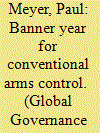

|
|
|
|
|
| Publication |
2014.
|
| Summary/Abstract |
THE CONTROL OF CONVENTIONAL ARMS HAS OFTEN SEEMED THE POOR COUSIN of the global efforts to control weapons of mass destruction (WMD). Since the advent of the atomic era, the focus of arms control and disarmament activity has been overwhelmingly on nuclear weapons and their lesser, if still ugly, stepsisters of biological and chemical weapons. The initial multilateral arms control agreements concerned themselves with limits on the testing of nuclear weapons and, shortly thereafter, with their nonproliferation (e.g., the Nuclear Nonproliferation Treaty of 1968). Bilateral US-Soviet/Russian arms control arrangements also predominantly dealt with the reduction of strategic nuclear forces and restraints on deployments of defenses against (nuclear tipped) ballistic missiles. Efforts to reduce major conventional weapon systems were also taken up in the 1980s in the context of negotiations
between the opposing alliances of NATO and the Warsaw Pact, eventually culminating in the Treaty on Conventional Forces in Europe (CFE Treaty) of 1989. This treaty provided for a massive reduction in the conventional forces that had confronted each other for years in Central Europe and established a new, far more stable security order on the continent. Even the CFE Treaty, however, tended to be overshadowed by other major disarmament agreements concluded in those heady post-Cold War days: the Intermediate Nuclear Forces Treaty (1987), Chemical Weapons Convention (1993), Comprehensive (Nuclear) Test Ban Treaty (1996), and various US-Russian bilateral strategic nuclear arms accords of the 1990s and early 2000s (e.g., the Strategic Arms Reduction Treaty and the Strategic Offensive Reductions Treaty).
|
|
|
|
|
|
|
|
|
|
|
|
|
|
|
|
| 2 |
ID:
091400
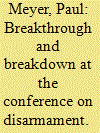

|
|
|
|
|
| Publication |
2009.
|
| Summary/Abstract |
The May 29 adoption of a program of work by the Conference on Disarmament (CD) in Geneva marked the first time in 11 years that the 65-member body had taken such action. That step was a cause for celebration as it appeared to open the door to the negotiation of a treaty banning the production of fissile material for nuclear weapons or other nuclear explosive devices.
|
|
|
|
|
|
|
|
|
|
|
|
|
|
|
|
| 3 |
ID:
179861
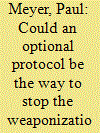

|
|
|
|
|
| Summary/Abstract |
Since the early 1980s, the United Nations General Assembly and its affiliated forum, the Conference on Disarmament in Geneva, has had the Prevention of an Arms Race in Outer Space issue on its agenda. In the intervening years, the threat of weapons being introduced into the outer space realm has waxed and waned, but, in the main, a benign environment free from man-made threats has prevailed, allowing for great strides in the exploration and use of space. Recently, a renewal of great power rivalry including the development of offensive “counter-space” capabilities has resurrected the spectre of armed conflict in space. With widespread political support for the non-weaponization of outer space, has the time come to give legal expression to this goal by means of an optional protocol to the 1967 Outer Space Treaty?
|
|
|
|
|
|
|
|
|
|
|
|
|
|
|
|
| 4 |
ID:
166069
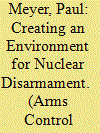

|
|
|
|
|
| Summary/Abstract |
Few would contest that the regime built on the nuclear Nonproliferation Treaty (NPT) is currently going through a rough patch, to put it mildly. Long-simmering frustrations with the lack of progress in fulfilling the treaty’s Article VI commitment on nuclear disarmament erupted in recent years in the form of a broadly based humanitarian initiative leading to the 2017 conclusion of the Treaty on the Prohibition of Nuclear Weapons.
|
|
|
|
|
|
|
|
|
|
|
|
|
|
|
|
| 5 |
ID:
104760
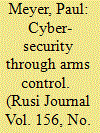

|
|
|
|
|
| Publication |
2011.
|
| Summary/Abstract |
The risk of cyber-warfare is growing. With a low-level technological requirement, it is a form of warfare that can be prosecuted by military and civilian, state and non-state actors alike. Its anonymity makes it difficult to trace perpetrators, complicating inter-state relations. But cyberspace is not yet an active battleground for cyber-warfare, and could still be amenable to conflict prevention and restraint measures. The time has come to adopt an 'arms control approach' to cyber-security.
|
|
|
|
|
|
|
|
|
|
|
|
|
|
|
|
| 6 |
ID:
152071
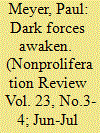

|
|
|
|
|
| Summary/Abstract |
International cooperation on outer-space security has fluctuated over the past decades, marked by periods of common endeavor and relative stability as well as times of destabilizing developments and rising tensions. A high-water mark of space-security diplomacy was the 2013 UN Group of Governmental Experts consensus report on “Transparency and Confidence-Building Measures in Outer Space Activities,” which set out a rich menu of measures and promised new levels of cooperative security among states. Regrettably, the report was followed by a series of negative developments that threaten to reverse the cooperative trend it espoused. These developments include the introduction (by Russia and China) and rejection (by the United States) of a revised draft treaty on the Prevention of Placement of Weapons in Outer Space (PPWT); the adoption by the UN General Assembly of a divisive resolution on “no first placement” of space weapons; the failure of the European Union to gain support for its proposed Code of Conduct, as well as escalating strategic tensions. This viewpoint analyzes the re-emergence of these “dark forces” and their implications for multilateral diplomacy and makes suggestions for remedial action to preserve outer-space security.
|
|
|
|
|
|
|
|
|
|
|
|
|
|
|
|
| 7 |
ID:
125593
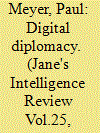

|
|
|
|
|
| Publication |
2013.
|
| Summary/Abstract |
As a relatively new domain for potential warfare, cyberspace is increasingly part of the international security agenda. Paul Meyer examines efforts to establish cyber safety rules and outlines the challenges faced in reaching an agreement on them.
|
|
|
|
|
|
|
|
|
|
|
|
|
|
|
|
| 8 |
ID:
114386
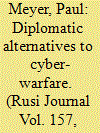

|
|
|
|
|
| Publication |
2012.
|
| Summary/Abstract |
International cyber-security is an increasingly pressing issue for leading national powers. The next few years will be crucial to the establishment of a coherent diplomatic framework: rather than wait and see what the haphazard conglomeration of state behaviours will bring, Paul Meyer argues that the international community needs to act now to define what constitutes legitimate state behaviour in cyberspace.
|
|
|
|
|
|
|
|
|
|
|
|
|
|
|
|
| 9 |
ID:
162158
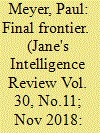

|
|
|
| 10 |
ID:
149871
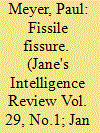

|
|
|
|
|
| Summary/Abstract |
After years of deadlock in the UN's nuclear disarmament forum, a new course of multilateral negotiations in being launched. Paul Meyer examines the diplomatic stalemate over global nuclear disarmament and the outlook for further progress in 2017.
|
|
|
|
|
|
|
|
|
|
|
|
|
|
|
|
| 11 |
ID:
139699
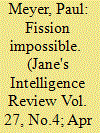

|
|
|
| 12 |
ID:
079943
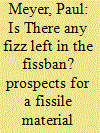

|
|
|
| 13 |
ID:
158017
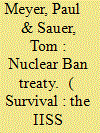

|
|
|
|
|
| Summary/Abstract |
Future historians may record summer 2017 as the beginning of the end of the nuclear age. On 7 July 2017, 122 states adopted the text of a legally binding international treaty that provides for a comprehensive ban on nuclear weapons (or ‘ban treaty’).1 The treaty was opened for signature on 20 September 2017, and at the time of writing, 56 states had signed and five had ratified.
|
|
|
|
|
|
|
|
|
|
|
|
|
|
|
|
| 14 |
ID:
152190
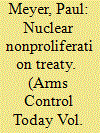

|
|
|
| 15 |
ID:
174045
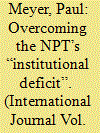

|
|
|
|
|
| Summary/Abstract |
Ever since the Nuclear Non-Proliferation Treaty was indefinitely extended in 1995, Canada has promoted the concept of “permanence with accountability.” Canada led on an ambitious initiative to enhance accountability via a reform package to overcome the NPT’s “institutional deficit.” Launched prior to the failed 2005 Review Conference, the effort was sustained for a decade. The priority goals were to establish annual meetings of states parties; to create a standing body of past, present, and future chairs; and to provide for the convening of extraordinary meetings. These ideas attracted support, but also opposition, from quarters less interested in having more effective tools of accountability put into place. The history of this initiative sheds light on the dynamics of multilateral diplomacy in the nuclear realm and on weaknesses in the Nuclear Non-Proliferation Treaty process that continue to threaten the authority of the treaty.
|
|
|
|
|
|
|
|
|
|
|
|
|
|
|
|
| 16 |
ID:
147848
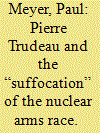

|
|
|
|
|
| Summary/Abstract |
Prime Minister Pierre Trudeau is known for his challenge to Canada’s NATO policy at the beginning of his tenure in power and his peace initiative at its end. Less well known is his support for innovative arms control policies designed to eliminate the technological impetus behind the nuclear arms race between the US and the USSR during the Cold War. At the first UN Special Session on Disarmament in May 1978, Trudeau delivered a speech outlining a “strategy of suffocation” that provided a novel package of four arms control measures that, taken as a whole, would represent an effective means of halting and eventually reversing the nuclear arms race. Although the superpowers were largely indifferent to them, these ideas helped spur the Department of External Affairs to invest in developing the institutional capacity to enable Canada to play a leadership role in future disarmament diplomacy.
|
|
|
|
|
|
|
|
|
|
|
|
|
|
|
|
| 17 |
ID:
108101
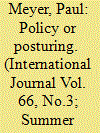

|
|
|
| 18 |
ID:
183788
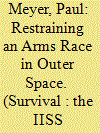

|
|
|
|
|
| Summary/Abstract |
The world is faced with an escalating arms race in outer space at the very time that this vital, if vulnerable, environment is experiencing rapid growth in orbiting satellites and the array of services they provide. After years of relative stagnation, multilateral diplomatic activity is being re-energised, spurred by the revival of debris-causing anti-satellite weapons (ASAT) tests. A British initiative has resulted in the creation of a new United Nations diplomatic forum on ‘Reducing Space Threats Through Norms, Rules and Principles of Responsible Behaviours’. Although geopolitical tensions between leading space powers make the development of cooperative security arrangements difficult, there is a common interest in avoiding the creation of more space debris that would endanger the assets of all space operators.
|
|
|
|
|
|
|
|
|
|
|
|
|
|
|
|
| 19 |
ID:
091673
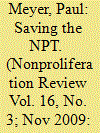

|
|
|
|
|
| Publication |
2009.
|
| Summary/Abstract |
For more than forty years, the Treaty on the Non-Proliferation of Nuclear Weapons (NPT) has provided major security benefits to the international community; however, the treaty is suffering from internal and external pressures, and benign neglect on the part of its members is undermining its authority. To ensure the treaty's continued viability, it is time for member states to start showing the NPT the respect it deserves and to renew their commitments to its fundamental purposes. Achieving this requires remedial action in at least four areas of vulnerability: reinvigorating nuclear disarmament; strengthening nonproliferation; overcoming the NPT's institutional deficit; and fostering a rapprochement between NPT and non-NPT states that does not abandon the goal of treaty universalization. There is still time before the 2010 NPT Review Conference for concerted action to restore the NPT's vitality and for the United States to resume its leadership role on behalf of the treaty and its membership.
|
|
|
|
|
|
|
|
|
|
|
|
|
|
|
|
| 20 |
ID:
109839
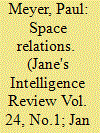

|
|
|